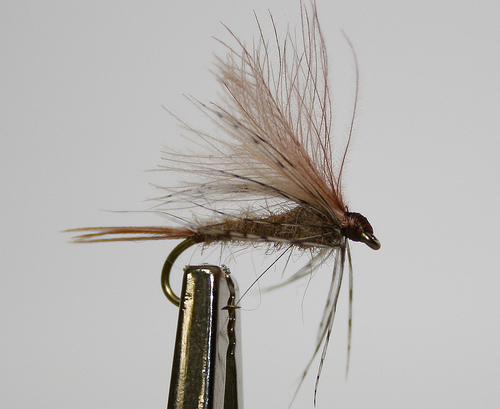
On The Fly
March 2012
"Fly tying is a school from which we never graduate"
TYING NEWS
The Southern Oregon Fly Tyers invite you to attend their meetings the second Tuesday of
each month. The next meeting is March 12, 2012. The meetings start at 6:00 PM, at the Madrone Hill
Mobile Home Park community building near Gold Hill. Bring a friend, come early so you don't miss
anything, and stay late. Tyers need not be experienced, and those with all levels of skill are
welcome. Each meeting a member is encouraged to demonstrate a new or different skill, from simple
to difficult. For more information, call Dan Kellogg at 773-4724.
DIRECTIONS: Take Gold Hill Exit #40, off of I-5 and go west, toward Jacksonville, 1.3 miles, until you
reach the brick entrance way to the Madrone Hill Mobile Home Park on the right. You’ll pass a golf course
parking lot on your left shortly after leaving the freeway. After you turn right into the
mobile home park, proceed to the community building which is located about 100 yards ahead on the left. The
address is 8401 Old Stage Rd. Please park your vehicle on the bare dirt in the parking lot to avoid the
wooden septic covers in the grass
 PATTERN OF THE MONTH -March Brown CDC Emerger
PATTERN OF THE MONTH -March Brown CDC Emerger
Hook: Daiichi 1560, 1X nymph, 12 & 14.
Thread: 6-0 Brown or Tan.
Tail: 3-5 Pheasant tail fibers.
Body: Natural Possum.
Hackle/Legs: Grey or brown partridge.
Wing: One medium brown & one light tan CDC feather.
Tying Instructions:
Step 1: Mash the barb and mount the hook in the vise.
Step 2: Start the thread one eye width behind the eye and lay down a smooth thread layer to a position just
above the point of the hook.
Step 3: Select 3 - 5 Pheasant tail fibers and tie them on top of the shank. Trim the butts just behind the
eye, bind down the butts with forward spiral wraps then back to the base of the tail.
Step 4: Dub the thread and wind forward forming a nicely tapered body ending at the 3/4 point on the shank.
Tie off and trim.
Step 5: Select a partridge feather with barbs as long as the shank, prepare the feather, tie in by the tip,
and wind one turn only. Tie off and trim excess.
Step 6: Select one brown and one light tan CDC feathers, stack the brown one on top with the tips even,
measure for one body length, and tie them just in front of the partridge. The thick body thorax and the
hackle turn should force the CDC barbs up at a 45 degree angle. Tie off and trim
Step 7: Form a neat tapered thread head, whip finish, and cement.
Since the first of the year, the Blue Wing Olive has been the predominate mayfly hatch
on the river providing the fly fisherman with some of the only dry fly action in the early season. The BWO
is the best known and most written about mayfly hatches in the country, but maybe the least fished. You
have to admire those hearty souls, praying for days of cold, overcast and drizzly weather to test their
latest tiny creation at fooling the sluggish trout.
To me spring is March, April, and May, when the second mayfly species to hatch is the
March Brown. They will appear when water temperatures start reaching 42 degrees consistently. Hatching
March Browns can create some very exciting surface film and dry fly fishing. As water warms at mid-day the
nymphs rise toward the surface to hatch. Some of these nymphs are intercepted by trout during this upward
migration. Often the rise starts much quieter as trout pick off the emergers just below the surface. A few
duns will emerge from the shuck slightly below the surface film. At this time the March Brown CDC Emerger
fished just below the surface can be your best fly choice.
Tying tips:
March Browns most often come in a size 14 but can vary in color from dark to light,
even grayish with tan underbodies and mottled brown wings. Use a variety of dubbing colors for your fly
inventory but pay most attention to the body shape. The dubbing technique requires a sparse amount on the
thread at the rear, and an increasing amount as you wind forward. Although there is not a separate thorax
material, the dubbing at the front of the body should resemble a thorax buildup. Take a good look at the
attached picture for matching proportions. The CDC keeps the head up and imitates the emerging wings
with trapped air bubbles and the sparse partridge imitates the legs. This is and easy tie using very common
materials. Best of all, once learned, you can vary the size and color to imitate any mayfly emerger
anywhere you travel.
So tie some up, give them a test flight, and let me know how you do.
Tie One On,
Dan Kellogg
(you can contact me at FLYGUY@EZNORTHWEST.COM)
www.tyerstoolshop.com